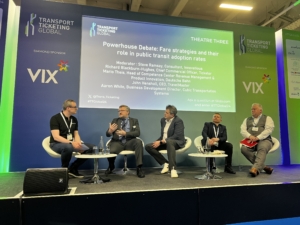 Transport Ticketing Global was an absolute blast! With insightful presentations, lively panel discussions, and plenty of public transport innovations to marvel at, the event once again outdid itself.
Transport Ticketing Global was an absolute blast! With insightful presentations, lively panel discussions, and plenty of public transport innovations to marvel at, the event once again outdid itself.
As there was so much to take in, we’re covering off some key TTG takeaways that are bound to shake up how we view public transport in the years to come…
(No) ticket to ride: Open payments and multi-tap
It’s no secret that open payments have been on the rise in the UK for several years, with more and more passengers ditching paper tickets in favour of tapping their cards for convenience. In research carried out by us last year, the difference between cash transactions and EMV in public transport was wide, with contactless at 21.9% compared to cash’s 16.2%.
Furthermore, with the cost-of-living crisis and rising fuel costs, the public transport industry has enjoyed a resurgence in ridership of late, meaning an increasing number of people rely on open payments to make their journeys. But is the public transport industry doing enough in this space to support passengers and create seamless travel experiences?
According to Gov.uk’s annual bus statistics, children made up 11% of total bus passengers last year. We know that travel to and from school accounts for a large proportion of these young passengers, but the UK bus industry shouldn’t overlook the number of families travelling together when it comes to open payments. The question being, do we currently support families enough within the UK public transport industry? Is boarding when purchasing multiple tickets on one card as efficient as it could be?
Open payments were reviewed at TTG in light of this question, and were identified as posing a challenge for family travel when the accompanying adult needs to tap on to purchase multiple bus tickets but are unable to do so in quick succession. This not only creates a barrier to travel for passengers but on the flip side increases dwell time for operators and makes it trickier to maintain a reliable service and keep buses running on schedule.
In one of the kick-off sessions at TTG, Bernardina Peerenboom, Product Manager for De Lijn, shared how they’ve introduced quick-fire multi-tap in Belgium to overcome this barrier. This nifty functionality allows passengers to tap the card machine several times in quick succession to buy multiple tickets, resolving any onboarding hiccups with family contactless payments. To make it work, De Lijn made all fares the same for each tap.
The catch? Higher travel costs for children given the flat fare allocated to tapping on and off. Plus, there’s the added risk of accidentally multi-tapping and being overcharged.
The payoff? Smoother boarding, easier payment, less forward planning and a cost-effective journey if travelling a relatively long distance. Plus, the hope of even more passengers opting to choose bus transport than other methods given the ease of onboarding.
It’ll be interesting to see if the UK decides to hop on the multi-tap bus in the future and how it might shake things up for passenger satisfaction, boarding speeds, and overall operational efficiency.
Navigating the ticket maze: Fare strategies and transport uptake
 When it comes to boosting public transport adoption rates, fare strategies undoubtedly play a pivotal role, as we’ve all seen with recent initiatives such as the £2 fare. But what do authorities and operators need to consider when it comes to deploying a successful fare strategy? How do we best use these to get as many passengers as possible on board our buses?
When it comes to boosting public transport adoption rates, fare strategies undoubtedly play a pivotal role, as we’ve all seen with recent initiatives such as the £2 fare. But what do authorities and operators need to consider when it comes to deploying a successful fare strategy? How do we best use these to get as many passengers as possible on board our buses?
Jason Mann, Ticketer’s Director of Product, shared his thoughts during a lively discussion with other panellists whilst at TTG.
The consensus among the panellists was crystal clear: simplicity is key when it comes to fare strategies and increasing adoption rates. But simplicity doesn’t mean a one-size-fits-all solution. A flat fare structure may seem straightforward, but it doesn’t necessarily benefit everyone. Passengers on longer journeys might feel the value, while those taking shorter trips may not feel like they’re getting their money’s worth.
To truly win over passengers, operators and authorities need to offer a range of options that cater to the diverse needs of all travellers. And most importantly, they need to build trust with their customers. Even the best fare strategy and prices won’t matter if customers don’t trust the services to be reliable and get them where they need to be, ticketing is just one piece of the puzzle in the public transport system the panel agreed.
A reliable transport ecosystem is crucial for passengers to confidently choose their mode of transport, pay using their preferred method, and trust that they’re being charged a fair fare (pardon the pun!).
Whether it’s through contactless EMV, Tap On / Tap Off systems, interacting with the driver when paying by cash, using a mobile app, or utilising an ITSO card, passengers must have faith in the operator or authority to provide a seamless and trustworthy travel experience.
Ultimately, the panel agreed: it’s all about building trust. If passengers know they can rely on public transport to get them where they need to go—at a fair price—they’ll keep coming back for more.
The rise of card virtualisation
The shift from physical to digital is changing the game, but what does this mean for operators and card virtualisation? Host, Tim Jefferson, kicked off a panel discussion titled ‘Revolutionising Transit Ticketing: The Power of Card Virtualisation’ by diving into the different ways card virtualisation can work. For example, converting a physical card into a digital one, like your bank card on your phone, or creating a digital card from scratch, like a travel pass you can access through your mobile wallet.
Kantar, a global data and insights researcher, says that the popularity of digital and mobile wallets is growing with a massive 92% of people reporting familiarity with these payment types, and 55% having used them to make transactions. But what’s driving this uptake, and what’s in it for passengers and operators?
For passengers, virtual cards bring convenience. With your smartphone always in your pocket, having your bus pass or payment card on your device means you’re always ready to go. Plus, virtual cards make paying for tickets quicker, making the whole travel experience that bit smoother.
Operators are also loving the benefits of more people using virtual cards, Stuart McLay from National Express says they’ve reduced cash by approximately 15% in the last 18 months, largely due to card virtualisation, and says they’re making cost savings by printing fewer physical tickets. But it’s not just about saving money; going digital also helps cut down on paper use, which is great for the environment, as well as less hassle with cash transactions for drivers. Handling cash can lead to errors, increased dwell time, and more paperwork. By switching to digital payments, getting on the bus becomes quicker and easier for passengers, helping buses stick to timetable and making the overall service more reliable.
But it’s not all smooth sailing. There are challenges, new technologies bring new ways for sneaky folks to cheat the system, and that’s a headache for operators. Fraudulent activity in mobile payment wallets like ‘Apple Pay’ and ‘Google Pay’ can be tricky to spot and stop.
We’ve helped overcome this with our recent ‘PAR Deny lists’ rollout with Littlepay. PAR Deny lists lower the likelihood of unpaid trips by detecting and preventing fraudulent behaviour at the account level, rather than solely concentrating on suspicious actions linked to individual card numbers (PAN). Unlike traditional approaches, which target questionable activities based on PAN, PAR Deny lists empower the ETM to obstruct all cards linked to a user’s account, regardless of the specific mobile wallet card number.
Looking ahead, the panel agreed the future of card virtualisation brings many benefits to both passengers and operators. And although new tech brings new challenges, operators and authorities are committed to finding new ways to utilise this technology and continue to enhance the passenger experience by making sure digital payments are reliable, speedy, and secure.
Unlocking value: using data to enhance the passenger experience
There’s no denying the significance of the data we collect from public transport, but are we making the most of it? The panel at TTG seemed to think not and shared insights into how operators, authorities, and suppliers can collaborate to better enhance transport services and improve the passenger experience.
Value isn’t just about the numbers on your balance sheet, they emphasised. It’s about using data to tackle pain points and remove barriers to travel for passengers. The introduction of the Bus Open Data Service (BODS) underscores this concept, with Triumph from the Department for Transport highlighting its aim to boost operational efficiencies, understand the most valuable ticket options, enhance local infrastructure, and improve service reliability. All these factors contribute to an overall better passenger experience, made possible by leveraging data effectively.
It’s understandable that the public might question why their data is needed and how it’s being used. That’s why transparency is crucial when it comes to utilising passenger data according to the panel. If passengers understand that their information is being used to tailor services to their needs, they may be more willing to share their data.
The panel also discussed how data can inform fare-setting and scheduling strategies, identify popular fares, ones that don’t get used anymore, bus stops that are getting increasingly busier, and highlight areas where adjustments are needed to better serve passengers.
However, despite the wealth of data available, the panel felt there to be a skills gap within the transport industry. They said many operators lack either the budget to outsource data analytics, or the internal resource to analyse data effectively and translate it into actionable insights to improve operations and the passenger experience. As a result, the full potential of available data often remains untapped.
From the panel’s viewpoint, if the industry can get to a point where data is more accessible and user-friendly, operators and authorities will find it much simpler to utilise this information to inform operational decisions and enhance their services and improve the overall passenger experience.

